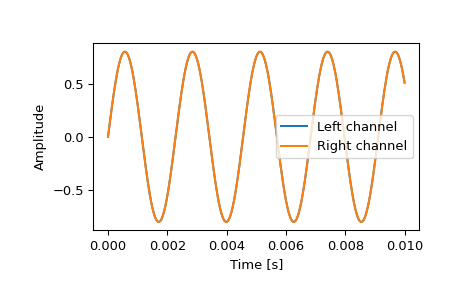read#
- scipy.io.wavfile.read(filename, mmap=False)[source]#
Open a WAV file.
Return the sample rate (in samples/sec) and data from an LPCM WAV file.
- Parameters:
- filenamestring or open file handle
Input WAV file.
- mmapbool, optional
Whether to read data as memory-mapped (default: False). Not compatible with some bit depths; see Notes. Only to be used on real files.
Added in version 0.12.0.
- Returns:
- rateint
Sample rate of WAV file.
- datanumpy array
Data read from WAV file. Data-type is determined from the file; see Notes. Data is 1-D for 1-channel WAV, or 2-D of shape (Nsamples, Nchannels) otherwise. If a file-like input without a C-like file descriptor (e.g.,
io.BytesIO) is passed, this will not be writeable.
Notes
Common data types: [1]
WAV format
Min
Max
NumPy dtype
32-bit floating-point
-1.0
+1.0
float32
32-bit integer PCM
-2147483648
+2147483647
int32
24-bit integer PCM
-2147483648
+2147483392
int32
16-bit integer PCM
-32768
+32767
int16
8-bit integer PCM
0
255
uint8
WAV files can specify arbitrary bit depth, and this function supports reading any integer PCM depth from 1 to 64 bits. Data is returned in the smallest compatible numpy int type, in left-justified format. 8-bit and lower is unsigned, while 9-bit and higher is signed.
For example, 24-bit data will be stored as int32, with the MSB of the 24-bit data stored at the MSB of the int32, and typically the least significant byte is 0x00. (However, if a file actually contains data past its specified bit depth, those bits will be read and output, too. [2])
This bit justification and sign matches WAV’s native internal format, which allows memory mapping of WAV files that use 1, 2, 4, or 8 bytes per sample (so 24-bit files cannot be memory-mapped, but 32-bit can).
IEEE float PCM in 32- or 64-bit format is supported, with or without mmap. Values exceeding [-1, +1] are not clipped.
Non-linear PCM (mu-law, A-law) is not supported.
References
[1]IBM Corporation and Microsoft Corporation, “Multimedia Programming Interface and Data Specifications 1.0”, section “Data Format of the Samples”, August 1991 http://www.tactilemedia.com/info/MCI_Control_Info.html
[2]Adobe Systems Incorporated, “Adobe Audition 3 User Guide”, section “Audio file formats: 24-bit Packed Int (type 1, 20-bit)”, 2007
Examples
>>> from os.path import dirname, join as pjoin >>> from scipy.io import wavfile >>> import scipy.io
Get the filename for an example .wav file from the tests/data directory.
>>> data_dir = pjoin(dirname(scipy.io.__file__), 'tests', 'data') >>> wav_fname = pjoin(data_dir, 'test-44100Hz-2ch-32bit-float-be.wav')
Load the .wav file contents.
>>> samplerate, data = wavfile.read(wav_fname) >>> print(f"number of channels = {data.shape[1]}") number of channels = 2 >>> length = data.shape[0] / samplerate >>> print(f"length = {length}s") length = 0.01s
Plot the waveform.
>>> import matplotlib.pyplot as plt >>> import numpy as np >>> time = np.linspace(0., length, data.shape[0]) >>> plt.plot(time, data[:, 0], label="Left channel") >>> plt.plot(time, data[:, 1], label="Right channel") >>> plt.legend() >>> plt.xlabel("Time [s]") >>> plt.ylabel("Amplitude") >>> plt.show()
